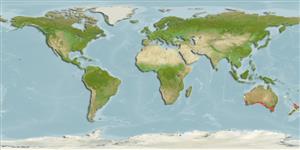Environment: milieu / climate zone / depth range / distribution range
Ökologie
seewasser demersal; tiefenbereich ? - 100 m (Ref. 9563). Temperate
Eastern Indian Ocean: southern Australia, from Western Australia to New South Wales and Tasmania.
Size / Gewicht / Alter
Maturity: Lm ? range ? - ? cm
Max length : 30.0 cm TL Männchen/unbestimmt; (Ref. 9563)
Rückenflossenstacheln (insgesamt): 4; Rückenflossenweichstrahlen (insgesamt): 8; Afterflossenweichstrahlen: 7. Dorsal sides of head and body light brown, ventral side white. Males with many small black blotches on head, body, and fins; females without black blotches. Caudal fin elongate, in males with 4 to 6 medial filaments; in females convex, without filaments. Preopercular spine with a dorsal point additionally to main tip, but without an antrorse spine at its base. First dorsal fin not much higher than second dorsal fin. Caudal fin in males with 5 or 6 median filaments (Ref 42832).
The name 'stinkfish' refers to the acid smell of the slime covering the body; the slime tastes bitter and may be toxic; only some birds of prey take this species (Ref. 557).
Life cycle and mating behavior
Geschlechtsreife | Fortpflanzung | Ablaichen | Eier | Fecundity | Larven
Paulin, C., A. Stewart, C. Roberts and P. McMillan, 1989. New Zealand fish: a complete guide. National Museum of New Zealand Miscellaneous Series No. 19. 279 p. (Ref. 5755)
IUCN Rote Liste Status (Ref. 130435)
Bedrohung für Menschen
Harmless
Nutzung durch Menschen
Mehr Information
NamenSynonymeMetabolismusRäuberÖkotoxikologieFortpflanzungGeschlechtsreifeAblaichenSpawning aggregationFecundityEierEientwicklung
ReferenzenAquakulturAquakultur ProfilZuchtlinienGenetikElectrophoresesVererbbarkeitKrankheitenVerarbeitungNutrientsMass conversion
PartnerBilderStamps, Coins Misc.LauteCiguateraGeschwindigkeitSchwimmstilKiemenoberflächeOtolithsGehirngrößeSehfähigkeit
Tools
Zusatzinformationen
Download XML
Internet Quellen
Estimates based on models
Preferred temperature (Ref.
123201): 14.1 - 17.9, mean 14.8 °C (based on 52 cells).
Phylogenetic diversity index (Ref.
82804): PD
50 = 0.5020 [Uniqueness, from 0.5 = low to 2.0 = high].
Bayesian length-weight: a=0.01148 (0.00455 - 0.02896), b=2.92 (2.70 - 3.14), in cm total length, based on LWR estimates for this (Sub)family-body shape (Ref.
93245).
Trophic level (Ref.
69278): 3.4 ±0.4 se; based on size and trophs of closest relatives
Widerstandsfähigkeit (Ref.
120179): mittel, Verdopplung der Population dauert 1,4 - 4,4 Jahre. (Preliminary K or Fecundity.).
Fishing Vulnerability (Ref.
59153): Low vulnerability (20 of 100).
Nutrients (Ref.
124155): Calcium = 49.5 [31.9, 93.9] mg/100g; Iron = 0.401 [0.262, 0.665] mg/100g; Protein = 18.4 [17.6, 19.2] %; Omega3 = 0.63 [0.39, 1.03] g/100g; Selenium = 12 [7, 22] μg/100g; VitaminA = 15.8 [5.0, 47.8] μg/100g; Zinc = 0.661 [0.492, 0.908] mg/100g (wet weight);
